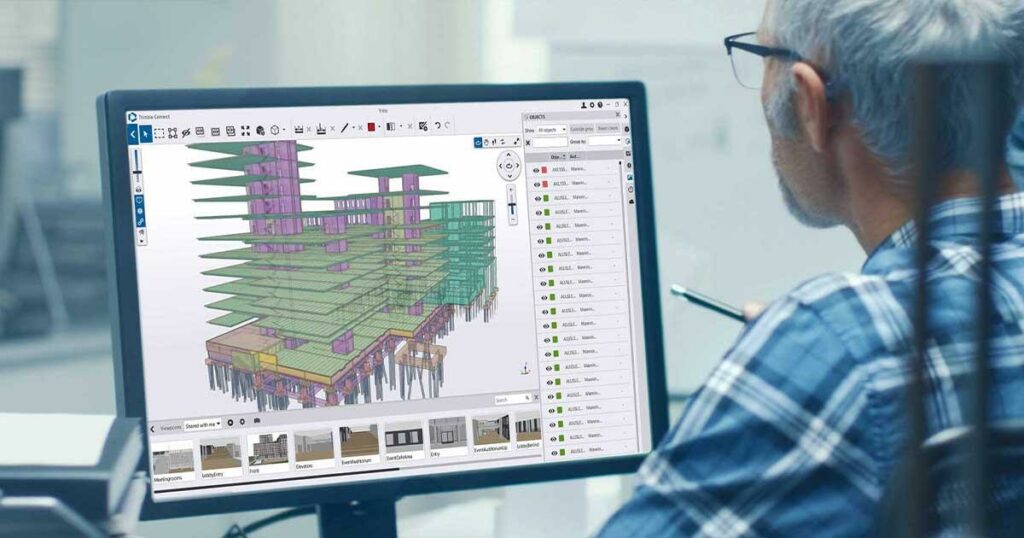BIM is a digital representation and complex system used in the creation and management of a construction project – from start to finish.
It’s become a vital part of construction projects and you’d be hard pushed to find one that doesn’t use BIM, so much so, it’s now a legal requirement for large scale and public builds to use BIM as part of their processes under the UK government Digital Built Britain scheme. This is all in a bid to improve efficiency and quality of the built environment.
BIM effectively coordinates a digital workflow of each aspect of a build. This includes 3D modelling, product and material data and digital structures.
An acronym for Building Information Modeling or Building Information Management, all manner of workers and individuals involved in a construction project are able to participate and contribute to the BIM management process.
From architects to engineers, as well as local authorities and contractors, everybody involved collaborates on the model from the design stage, to its approval and construction.
Notably, the data can be shared and accessed by BIM managers and the client who can use the BIM model and information to make decisions regarding the build. This data and information remains accessible even after construction has been completed.
In the past, we relied on blueprints and drawings to communicate building plans but this came with a list of disadvantages. It was often difficult to accurately visualise dimensions, record keeping could be an issue, they were easier to lose or damage and there’d also be no audit trail.
CAD (Computer Aided Design) came along to help improve this, allowing drafters and workers to see digital 3D plans. Today, we have BIM, allowing for support and collaboration at every phase of construction.

Key Features of BIM Technology
In short, BIM software works by taking survey data, designs and considerations to create three-dimensional (3D) objects. These objects combine to create a digital building model alongside a digital workflow from field to finish – for everyone from the architect to the contractors, to the building inspector and stakeholders.
The model contains data describing the building materials, the dimensions and the various components of the construction. The data can be converted into 2D drawings, allowing you to create digital workflows from office to site that would have one source of truth and audit trails.
It allows individuals involved – either directly or indirectly – in the construction to gain insight into various aspects of the build seamlessly for maximum efficiency.
As a result, the data generated can reveal design problems that can be circumnavigated early on by architects and engineers.
The Benefits of BIM Technology
A question many ask is what are the benefits of using BIM in construction projects?
BIM software comes with a slew of them. Here are some of the many advantages:
Better Collaboration and Communication
A key benefit of using BIM in a construction project is that it helps facilitate and finetune communication between all professionals involved.
Everybody is able to clearly see the virtual model of the building, meaning everyone has clear insight into the project and its requirements. A further benefit of this is that it can prevent any misunderstandings arising which in turn helps prevent delays in construction.
Enhanced Efficiency
The process of creating 2D drawings is significantly expedited using BIM tools. In fact, this is a big part of its appeal: it saves architects and designers a lot of time at the drawing stage.
Improved Quality Control
Design and construction problems can be identified early on through digital visualisations of the building. This is a huge time and resource saver and also helps to ensure a high quality project completion.
Lower Costs
Through early detection of potential problems in the construction project, costly errors can be avoided.
Quicker Construction Life Cycle
By employing BIM tools, the whole construction process from start to finish can be planned and monitored with close precision, eliminating communication hold-ups and potential delays.
More Sustainable
A building’s carbon footprint can be brought down significantly by using BIM analysis tools to optimise energy efficiency.
Types of BIM Software
There is a variety of BIM software on the market with each designed to play a significant role in the overall BIM process. As an authorised Trimble distributor, we focus on the following BIM software:
- Trimble FieldLink
- Trimble Field Points
- Trimble Connect
- Trimble Connect AR
- Trimble Connect MR
- Trimble CloudEngine

Let’s take a look at the BIM lifecycle and which phase of the project you might use each piece of software:
Applications of BIM Technology in Construction
A lot of people wonder what is the purpose of BIM technology? But the answer is varied as it supports a number of processes in the construction journey. Below we’ll discuss some of the key ones.
Design and Visualisation of Building Structures
Using BIM software such as FieldLink and Field Points, and hardware such as laser scanning equipment and total stations, designers, architects and engineers can gather invaluable insight into the intricacies of the site to enable them to create a model for the project.
Designers can pick from a library of building elements, including windows, doors, plumbing and ventilation, heating and cooling systems as well as things like stairs and elevators, which can be quickly added to the design. These elements are parametric, meaning they can easily be resized and customised to perfectly fit with the project.
They can also assemble photo-realistic renderings which can be presented to stakeholders or clients – or indeed used for marketing purposes. Renderings are often very important for giving those concerned a clearer insight into what the end result will be.
BIM tools can also generate important documents like floor plans and elevations which can be passed on to construction workers.
Construction Project Management and Scheduling
BIM tools such as Trimble Connect, Connect AR and Connect MR can be used to assist in the planning, management and scheduling of a construction project. It can do this by offering smart 3D computer models, which can contribute to the management of survey, design, engineering and building.
Collected site survey data can be input to generate a 3D computer model of a building.
Architects, engineers and anyone involved in the building process can use the model to plan and collaborate on the construction.
At the design phase, a digital version of the building will be proposed. This model can be used to test design ideas, the integrity of the structure as well as practical concerns such as energy efficiency and fire safety.
Once the design and planning phase is completed, BIM can create scheduling and track the ongoing build.
As the build moves forward, tools like CloudEngine can be used to communicate updates with technical collaborators and non-technical stakeholders through easy to understand modelling and real-time simulations to keep track of progress.
BIM Data Management and Analysis
3D clash detection also plays a role in construction management. It’s a process whereby contractor’s different models are merged to identify any problems. Other ways are through 4D sequencing and virtual mock-ups which can assess the quality of the construction.
Facility Management and Maintenance
BIM can also provide quantifiable insights valuable to facility management post build.
For instance, it can tell you a building’s predicted energy expenditure, as well as how much maintenance will cost. It does this in part by providing information about things like the durability of materials and the weather conditions of the site – which provides a clear idea of how often components will need to be repaired or replaced.
While in the past a balance sheet and other documents might give you some idea of these things, looking at a building model and seeing in detail how those costs will look is much more accurate and easy to put into practice.

What is the future of BIM technology?
BIM offers a number of benefits, meaning it is likely not going anywhere.
Architects, engineers and construction workers stand to benefit from the insight BIM can provide them with, and we will see this digital collaboration via the BIM process continue to develop and be optimised.
As BIM technology develops, we will also start to see 4D, 5D, 6D and 7D BIM come into the picture.
Additionally, it could play a valuable role in reducing waste in construction. A lot of this waste is due to supply chain errors and having to rebuild or rework problems. The collaborative nature of the BIM environment helps prevent these issues, making such waste less likely to occur in future projects.
Looking to the future, BIM has huge potential and this potential is only just coming into view. With new tools and greater optimisation at every level of building construction, we will likely see far more fine-tuned, enhanced and optimised building processes going forward.
Efficiency, Accuracy and Collaboration
BIM-enabled construction processes provide greater efficiency, visualisation and collaboration throughout a design and construction project.
It can assist communication between those involved, including stakeholders and local authorities that will approve planning permission. As a platform, it can help ensure all individuals involved are working towards the same clearly defined construction goal.
Companies use BIM today due to its value at each and every phase of construction – from its initial design to maintenance of the facility. With analysis tools it can identify areas of improvement and run predictions for how often upkeep and repair will be required. At the time of a building’s completion, it can still provide insight into a building’s operations making it a highly valuable, comprehensive process for construction.
BuildingPoint UK & Ireland are proud to supply the highest quality Trimble surveying equipment and BIM solutions to the construction industry.
Our mission is to empower you to measure, map and manage the natural and built environment with ease. If you have any questions about BIM technology and software, or you’d like to hire Trimble survey equipment, our knowledgeable team is always on hand to help, just get in touch!

